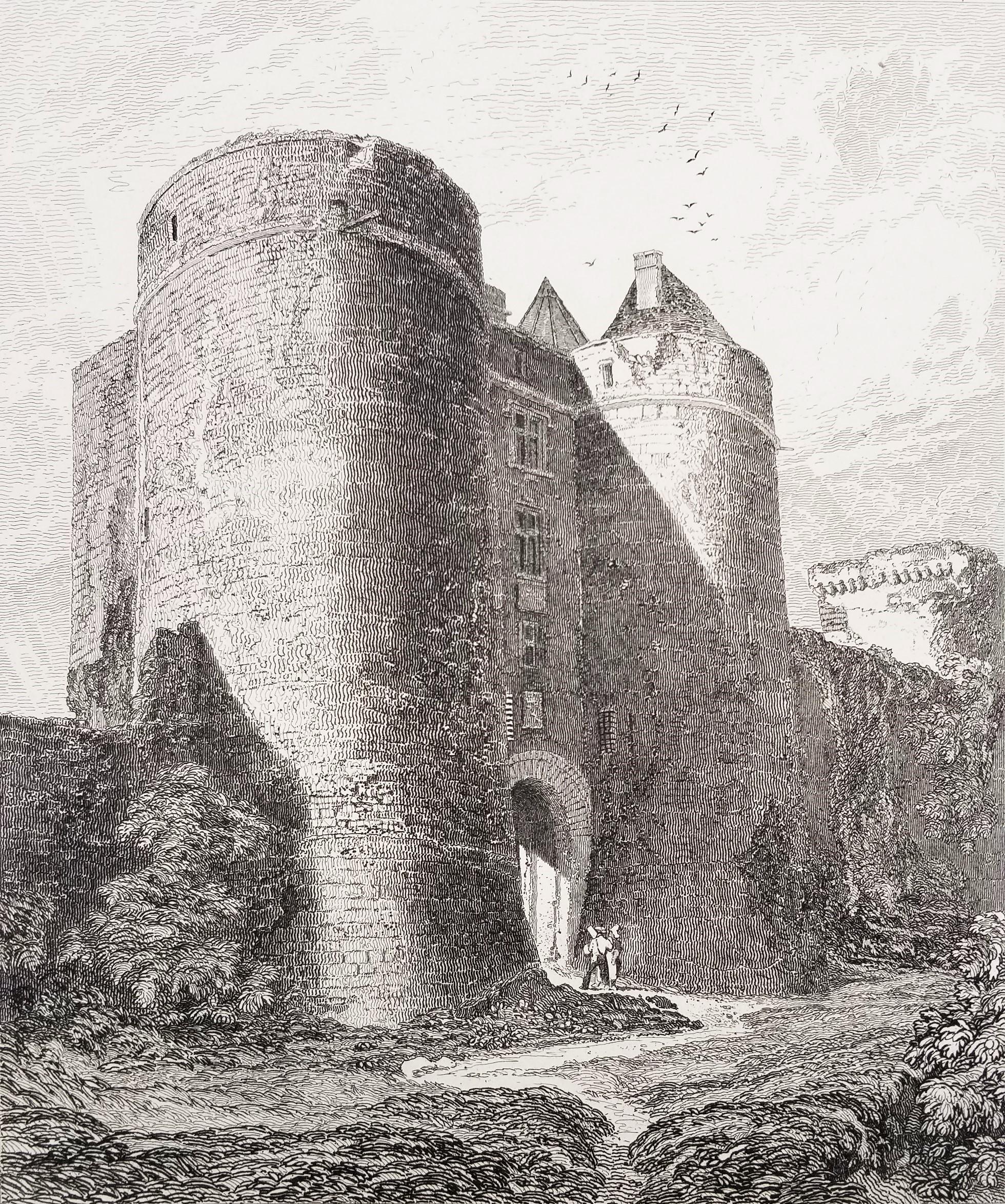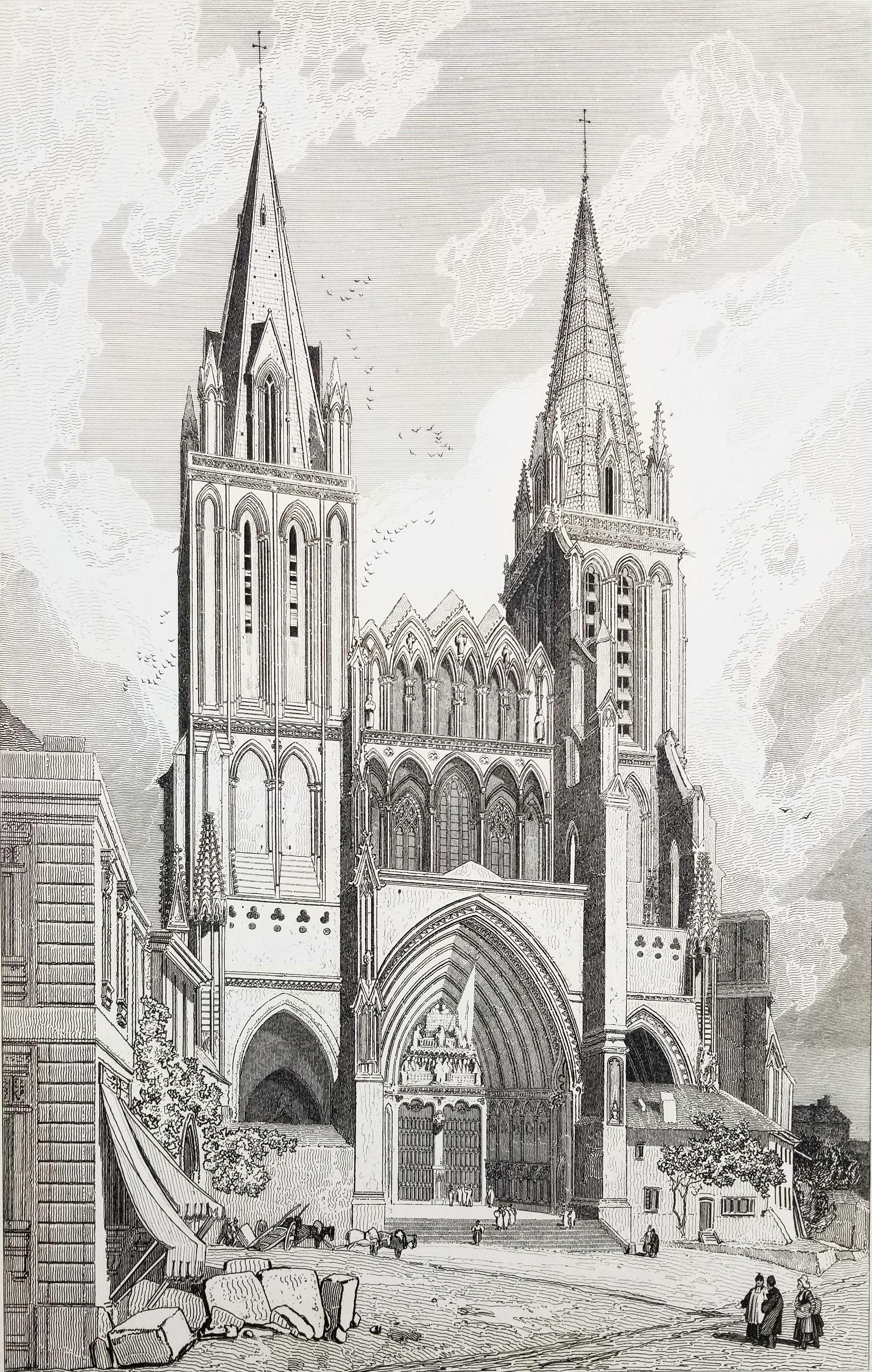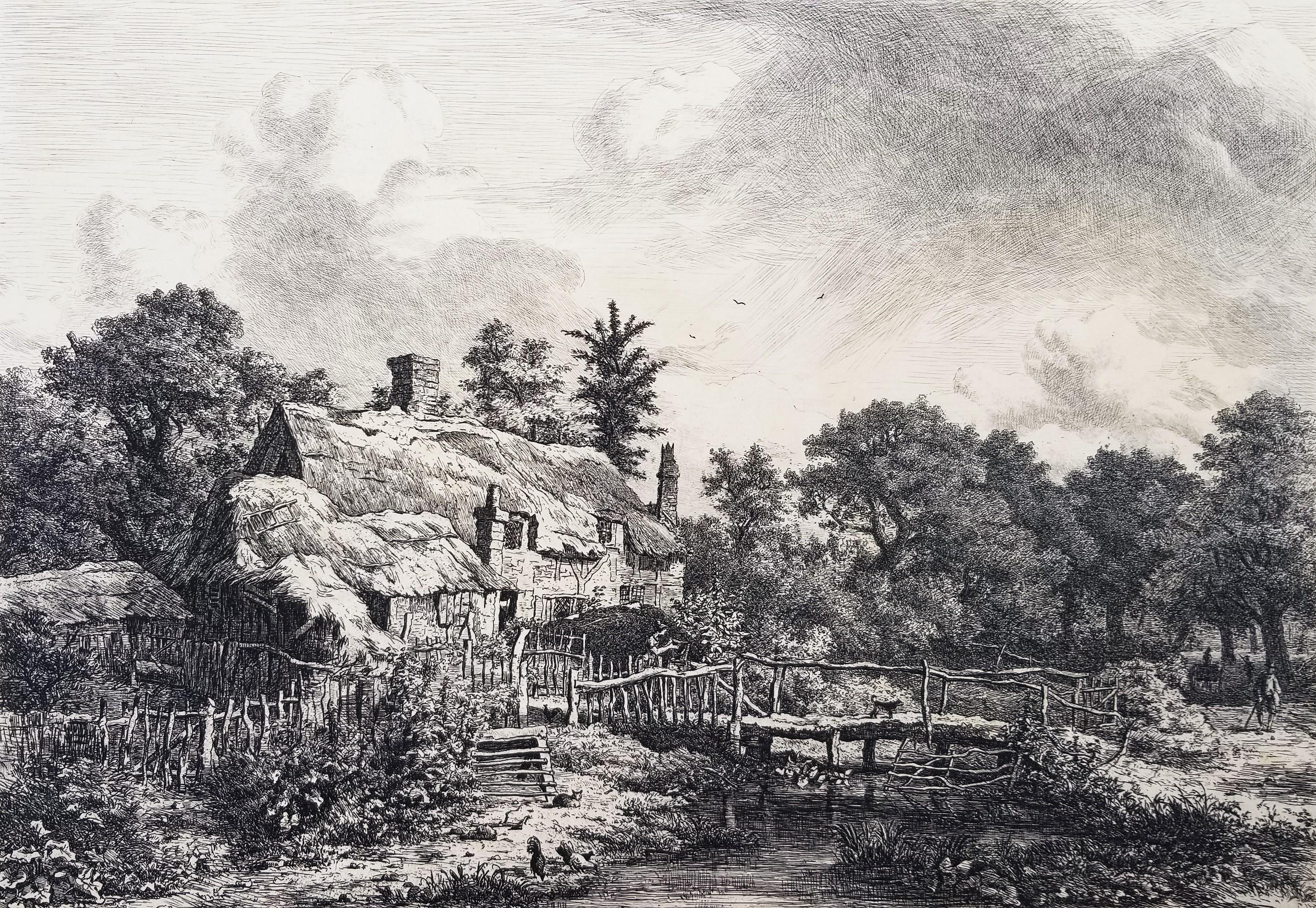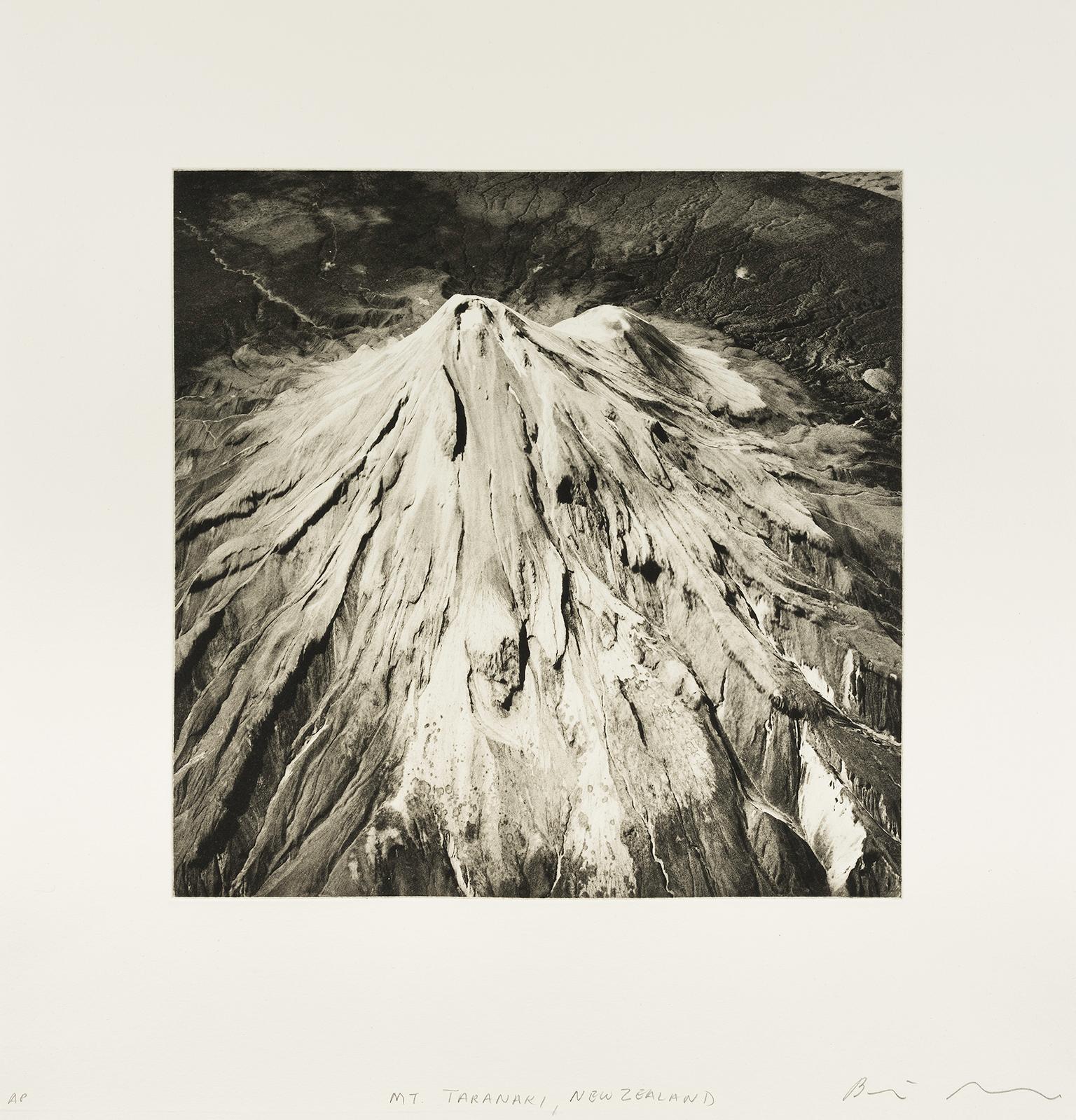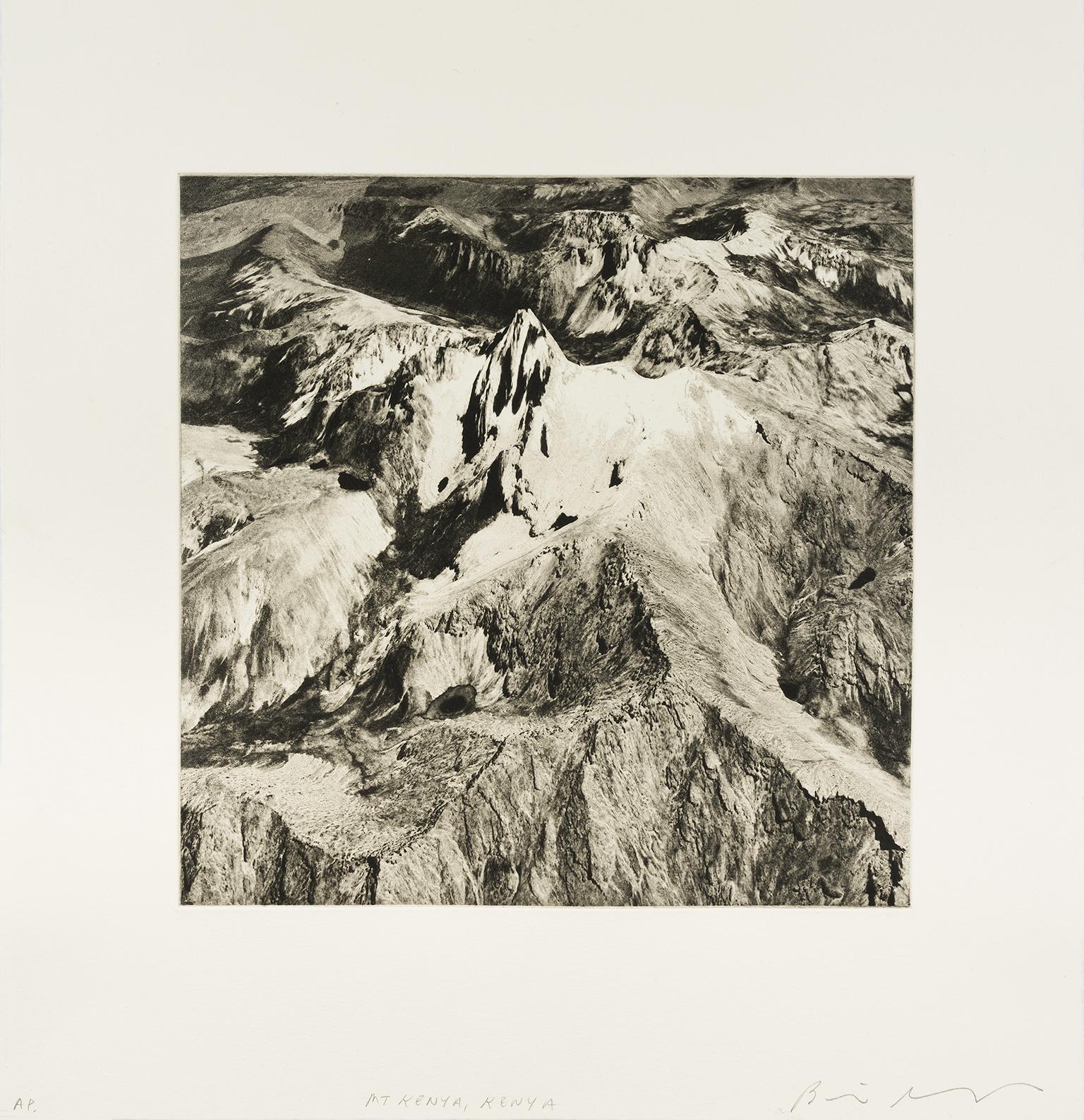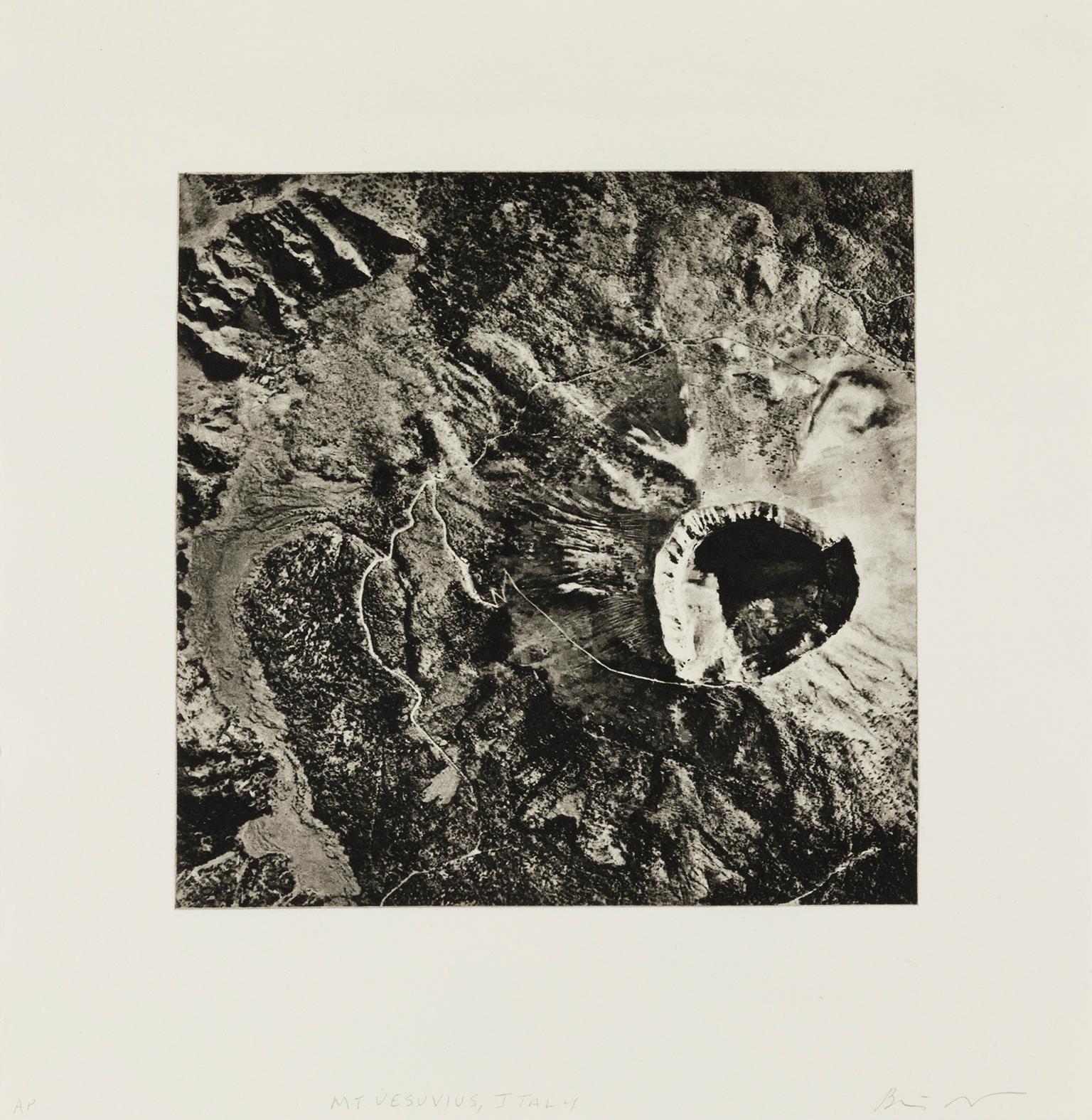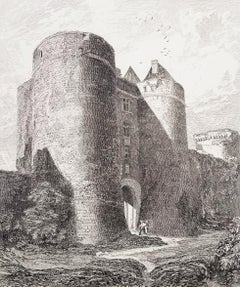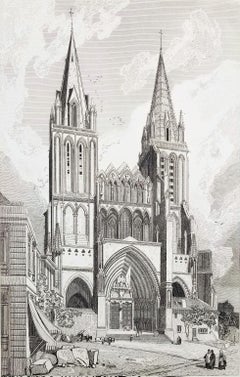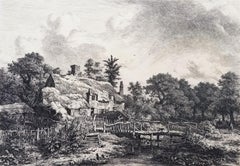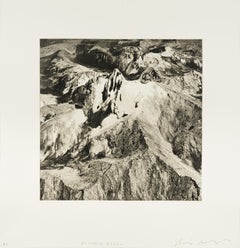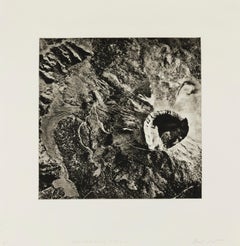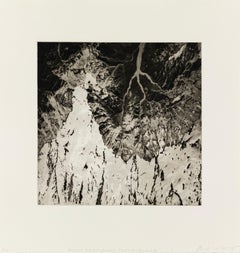Items Similar to Near Stoneleigh, Warwickshire /// British Victorian Landscape Etching Black Art
Want more images or videos?
Request additional images or videos from the seller
1 of 18
Jacob George StruttNear Stoneleigh, Warwickshire /// British Victorian Landscape Etching Black Art1828
1828
About the Item
Artist: Jacob George Strutt (English, 1784-1867)
Title: "Near Stoneleigh, Warwickshire"
Portfolio: Deliciae Sylvarum or Grand and Romantic Forest Scenery in England and Scotland
*Monogram signed by Strutt in the plate (printed signature) lower right
Year: 1828
Medium: Original Etching on chine appliqué on heavy wove paper
Limited edition: Unknown
Printer: Unknown
Publisher: Jacob George Strutt, London, UK
Sheet size: 14.25" x 21.13"
Image size: 10.38" x 13.94"
Condition: Minor soiling and discoloration in margins. A few light areas of waterstaining at right and bottom edges in margins. It is otherwise a strong impression in very good condition
Very rare
Notes:
There is an example of this work within the permanent collection of the British Museum, London, UK and the National Gallery of Ireland, Dublin, Ireland.
Biography:
Jacob George Strutt (4 August 1784 – 1867) was a British portrait and landscape painter and engraver in the manner of John Constable. He was the husband of the writer Elizabeth Strutt, and father of the painter, traveller and archaeologist Arthur John Strutt.
Strutt was born on 4 August 1784 in Colchester, in Essex, one of eight children of Benjamin Strutt and Caroline, née Pollett. In London, on 8 November 1813, he married Elizabeth Byron, with whom he had four children; their second son, Arthur John Strutt, was born in 1819. Strutt moved to Lausanne in Switzerland in about 1830. With his son Arthur he travelled in France and Switzerland from 1835 to 1837, and later to Italy; they established a studio in Rome. He returned to England in 1851, and died in Rome in 1864 or 1867.
Strutt painted portraits and landscapes, mainly in gouache, in the style of Constable, with whom he may have studied. He was also a capable engraver. He showed work in London between 1819 and 1858. At the Royal Academy he exhibited from 1822 to 1852; in 1822 and 1823 he showed portraits, but from 1824 until 1831 showed only woodland or forest scenes. Two paintings were sent from Italy while he was living there: The Ancient Forum, Rome in 1845, and in 1851 Tasso's Oak, Rome. He published two books of poetry in translation, and several books of engravings.
About the Seller
5.0
Platinum Seller
Premium sellers with a 4.7+ rating and 24-hour response times
Established in 1978
1stDibs seller since 2015
1,307 sales on 1stDibs
Typical response time: <1 hour
- ShippingRetrieving quote...Shipping from: Saint Augustine, FL
- Return Policy
Authenticity Guarantee
In the unlikely event there’s an issue with an item’s authenticity, contact us within 1 year for a full refund. DetailsMoney-Back Guarantee
If your item is not as described, is damaged in transit, or does not arrive, contact us within 7 days for a full refund. Details24-Hour Cancellation
You have a 24-hour grace period in which to reconsider your purchase, with no questions asked.Vetted Professional Sellers
Our world-class sellers must adhere to strict standards for service and quality, maintaining the integrity of our listings.Price-Match Guarantee
If you find that a seller listed the same item for a lower price elsewhere, we’ll match it.Trusted Global Delivery
Our best-in-class carrier network provides specialized shipping options worldwide, including custom delivery.More From This Seller
View AllEntrance to the Castle at Tancarville /// John Sell Cotman Architectural Etching
By John Sell Cotman
Located in Saint Augustine, FL
Artist: John Sell Cotman (English, 1782-1842)
Title: "Entrance to the Castle at Tancarville" (Vol. 2, Plate 86)
Portfolio: Architectural Antiquities of Normandy
Year: 1822
Medium: Or...
Category
1820s Victorian Landscape Prints
Materials
Etching, Intaglio
Cathedral Church of Notre Dame, at Séez /// John Sell Cotman Architectural Print
By John Sell Cotman
Located in Saint Augustine, FL
Artist: John Sell Cotman (English, 1782-1842)
Title: "Cathedral Church of Notre Dame, at Séez (West Front)" (Vol. 2, Plate 99)
Portfolio: Architectural Antiquities of Normandy
Year: ...
Category
1820s Victorian Landscape Prints
Materials
Etching, Intaglio
Cottage in the Forest of Arden /// British Victorian Landscape Cottage Etching
Located in Saint Augustine, FL
Artist: Jacob George Strutt (English, 1784-1867)
Title: "Cottage in the Forest of Arden"
Portfolio: Deliciae Sylvarum or Grand and Romantic Forest Scenery in England and Scotland
Year: 1829
Medium: Original Etching on chine appliqué on heavy wove paper
Limited edition: Unknown
Printer: Unknown
Publisher: Jacob George Strutt, London, UK
Sheet size: 14.07" x 21.13"
Image size: 9.63" x 13.82"
Condition: Minor soiling and discoloration in margins. Light areas of waterstaining about sheet mainly in margins. It is otherwise a strong impression in very good condition
Very rare
Notes:
There is an example of this work within the permanent collection of the British Museum, London, UK and the National Gallery of Ireland, Dublin, Ireland.
Biography:
Jacob George Strutt (4 August 1784 – 1867) was a British portrait and landscape painter and engraver in the manner of John Constable. He was the husband of the writer Elizabeth Strutt, and father of the painter, traveller and archaeologist Arthur John Strutt...
Category
1820s Victorian Landscape Prints
Materials
Etching, Intaglio
Dieu, Le Temps, L'Espace et le Pape (God, Time, Space, and the Pope) /// Dali
By Salvador Dalí
Located in Saint Augustine, FL
Artist: Salvador Dali (Spanish, 1904-1989)
Title: "Dieu, Le Temps, L'Espace et le Pape (God, Time, Space, and the Pope)"
Portfolio: After 50 Years of Surrealism
*Signed by Dali in pencil lower right
Year: 1974
Medium: Original Etching with Pochoir on Arches paper
Limited edition: A67/A195
Printer: Atelier Rigal, Paris, France
Publisher: Transworld Art, New York, NY
Reference: "The Official Catalog of the Graphic Works of Salvador Dali" - Field No. 74-8-I, page 94-95; "Dali: Catalogue Raisonné of Etchings and Mixed-Media Prints, 1924-1980" - Michler/Löpsinger No. 667, page 224
Sheet size: 26" x 19.75"
Image size: 15.75" x 12"
Condition: The colors attenuated. In otherwise very good condition with clean paper
Notes:
Provenance: private collection - Bedford...
Category
1970s Surrealist Landscape Prints
Materials
Etching, Intaglio
Crab Boats, Southampton Water /// Impressionist British Seascape Ship Maritime
By Aileen Mary Elliot
Located in Saint Augustine, FL
Artist: Aileen Mary Elliot (English, 1896-1966)
Title: "Crab Boats, Southampton Water"
*Signed by Elliot in pencil lower right
Circa: 1925
Medium: Original Drypoint Etching on laid p...
Category
1920s Impressionist Landscape Prints
Materials
Drypoint, Etching, Laid Paper, Intaglio
Benevolent Cottagers /// English Landscape Figurative Village Scene Engraving
Located in Saint Augustine, FL
Artist: (after) Sir Augustus Wall Callcott (English, 1779-1844)
Title: "Benevolent Cottagers"
Year: 1816
Medium: Original Etching and Engraving on laid paper
Limited edition: Unknown...
Category
1810s Old Masters Landscape Prints
Materials
Engraving, Etching, Laid Paper, Intaglio
You May Also Like
'Mount Taranaki, New Zealand' — from the series 'Axis Mundi', Contemporary
Located in Myrtle Beach, SC
Beth Ganz, 'Mount Taranaki, New Zealand', copperplate photogravure etching, edition 10, 2020. Signed, titled, and numbered 6/10 in pencil. A superb, richly-inked impression in warm black ink, on cream, wove, cotton rag paper; the full sheet in excellent condition. Archivally sleeved, unmatted.
Image size 10 1/2 x 10 1/2 inches; sheet size 16 x 15 1/2 inches.
From the artist's series of 64 photogravure etchings 'Axis Mundi'. Additional works from the series are available; please inquire.
Exhibited: 'Photography in Ink, A Look at Contemporary Copper-Plate Photogravure,' Curated by Leandro Villaro, Penumbra Exhibition Space Gallery, Nov 30, 2022 - March 15, 2023.
ABOUT THE IMAGE
Mount Taranaki (Māori: Taranaki Maunga) is a dormant stratovolcano in the Taranaki region on the west coast of New Zealand's North Island. At 2,518 meters (8,261 ft), it is the second-highest mountain on the North Island after Mount Ruapehu. It has a secondary cone, Fanthams Peak (Māori: Panitahi), 1,966 meters (6,450 ft), on its south side.
Taranaki is geologically young, having commenced activity approximately 135,000 years ago. The most recent volcanic activity was the production of a lava dome in the crater and its collapse down the side of the mountain in the 1850s or 1860s. The last major eruption occurred around 1655. Recent research has shown that over the last 9,000 years, minor eruptions have occurred roughly every 90 years on average, with major eruptions every 500 years.
The name Taranaki is from the Māori language. The mountain was named after Rua Taranaki, the first ancestor of the iwi (tribe) called Taranaki, one of several iwi in the region. The Māori word tara means mountain peak, and naki may come from ngaki, meaning ‘clear of vegetation.’ It was also named Pukehaupapa (’ice mountain’) and Pukeonaki (’hill of Naki’) by iwi who lived in the region in "ancient times".
Captain Cook named it Mount Egmont on 11 January 1770 after John...
Category
21st Century and Contemporary Contemporary Landscape Prints
Materials
Etching, Photogravure
'Mount Kenya, Kenya' — from the series 'Axis Mundi', Contemporary
Located in Myrtle Beach, SC
Beth Ganz, 'Mount Kenya, Kenya', copperplate photogravure etching, edition 10, 2020. Signed, titled, and numbered 6/10 in pencil. A superb, richly-inked im...
Category
21st Century and Contemporary Contemporary Landscape Prints
Materials
Etching, Photogravure
'Mount Vesuvius, Italy' — from the series 'Axis Mundi', Contemporary
Located in Myrtle Beach, SC
Beth Ganz, 'Mount Vesuvius, Italy', copperplate photogravure etching, edition 10, 2020. Signed, titled, and numbered 6/10 in pencil. A superb, richly-inked impression in warm black ink, on cream, wove, cotton rag paper; the full sheet in excellent condition. Archivally sleeved, unmatted.
Image size 10 1/2 x 10 1/2 inches; sheet size 16 x 15 1/2 inches.
From the artist's series of 64 photogravure etchings 'Axis Mundi'. Additional works from the series are available; please inquire.
Exhibited: 'Photography in Ink, A Look at Contemporary Copper-Plate Photogravure,' Curated by Leandro Villaro, Penumbra Exhibition Space Gallery, Nov 30, 2022 - March 15, 2023.
ABOUT THE IMAGE
Mount Vesuvius (Italian: Vesuvio) is a somma-stratovolcano located on the Gulf of Naples in Campania, Italy, about 9 km (5.6 mi) east of Naples and a short distance from the shore. It is one of several volcanoes forming the Campanian volcanic arc. Vesuvius consists of a large cone partially encircled by the steep rim of a summit caldera, resulting from the collapse of an earlier, much higher structure.
The eruption of Mount Vesuvius in AD 79, one of the most catastrophic eruptions of all time, destroyed the Roman cities of Pompeii, Herculaneum, Oplontis, Stabiae, and several other settlements. The eruption ejected a cloud of stones, ashes and volcanic gases to a height of 33 km (21 mi). More than 1,000 people are thought to have died in the eruption.
Vesuvius has erupted about three dozen times since. It is the only volcano on Europe's mainland to have erupted in the last hundred years (1929 and 1944). It is regarded as one of the most dangerous volcanoes in the world—3,000,000 people live near enough to be affected by an eruption, with at least 600,000 in the danger zone, the most densely populated volcanic region in the world. Eruptions tend to be violent and explosive; these are known as Plinian eruptions.
Vesuvius has a long historical and literary tradition. It was considered a divinity of the Genius type (a divine nature much like a guardian angel) at the time of the eruption of AD 79: it appears under the inscribed name Vesuvius as a serpent in the decorative frescos of many household shrines, surviving from Pompeii.
The Romans regarded Mount Vesuvius as being devoted to Hercules. The historian Diodorus Siculus relates a tradition that Hercules, in the performance of his labors, passed through the country of nearby Cumae on his way to Sicily and found there a place called 'the Phlegraean Plain' ('plain of fire') 'from a hill which anciently vomited out fire ... now called Vesuvius.' It was inhabited by giant bandits, 'the sons of the Earth'. With the gods' assistance, he pacified the region and continued his journey.
The area around Vesuvius was officially declared a national park on June 5, 1995. The summit of Vesuvius is open to visitors, and the park authorities maintain a small network of paths around the volcano. There is access by road to within 200 meters (660 ft) of the summit and a spiral walkway around the volcano from the road to the crater.
ABOUT THE SERIES 'AXIS MUNDI'
"This body of work focuses on satellite images of sacred mountains around the world—places where heaven and earth are thought to meet. The phenomenon of revering mountains as holy sites is an archetype found in many cultures.
"This shared experience finds a visual echo in the ubiquity of images of the earth that are now available to any person with a computer and an Internet connection. What does the specificity of place mean when we can move across the surface of the earth in seconds and reduce everything to a series of pixels? To me, this process recalls abstract painting, which transforms the specific into gesture and form. Rather than treat digital technology as necessarily destructive to human meaning and experience, my work offers new ways of seeing that are reconcilable with the old. To this end, I combine 19th Century Photogravure technique with 21st Century surveillance captures.
"Axis Mundi consists of 64 copperplate photogravures. The work is laid out in a grid, which is an arbitrary conversion of the visual world into a flat space that happens both on the picture plane and in the data processing. The title refers to the belief in a 'world center,' often conceived of as a mountain: a place where communication between higher and lower realms is possible. This project is a search for such a center in a world of decentralization and fragmentation."
—Beth Ganz
ABOUT THE ARTIST
Beth Ganz is a contemporary American multidisciplinary visual artist, who lives and works in New York City. She graduated from Pratt Institute with a BFA (honors) in Painting, Sculpture, and Printmaking. The focus of her work is the intersection of landscape, digital technology, and abstraction. Ganz works in paint, brush, and ink drawing, both independently and alongside digital and analog printing techniques, including photogravure and intaglio printing.
Ganz’s work has been the subject of many solo exhibitions, including 'Atlas Project' at Cynthia-Reeves Gallery, 'Up Close and Far Away, Grids and Toiles: Beth Ganz at Wave Hill House,' Wave Hill, and 'Geothermal Topographies' at Reeves Contemporary. She has been shown in numerous group exhibitions, and her work is represented in many public and private collections, including the 9-11 Memorial Museum, the Library of Congress, the New York Historical Society, and the New York Public Library Prints...
Category
21st Century and Contemporary Contemporary Landscape Prints
Materials
Etching, Photogravure
'Mount St. Elias, Yukon, Alaska' — from the series 'Axis Mundi', Contemporary
Located in Myrtle Beach, SC
Beth Ganz, 'Mount St. Elias, Yukon, Alaska', copperplate photogravure etching, edition 10, 2021. Signed, titled, and numbered 6/10 in pencil. A superb, richly-inked impression in warm black ink, on cream, wove, cotton rag paper; the full sheet in excellent condition. Archivally sleeved, unmatted.
Image size 10 1/2 x 10 1/2 inches; sheet size 16 x 15 1/2 inches.
From the artist's series of 64 photogravure etchings 'Axis Mundi'. Additional works from the series are available; please inquire.
Exhibited: 'Photography in Ink, A Look at Contemporary Copper-Plate Photogravure,' Curated by Leandro Villaro, Penumbra Exhibition Space Gallery, Nov 30, 2022 - March 15, 2023.
ABOUT THE IMAGE
Mount Saint Elias, the second-highest mountain in Canada and the United States stands on the Yukon and Alaska border about 26 miles (42 km) southwest of Mount Logan, the highest mountain in Canada. The Canadian side of Mount Saint Elias forms part of Kluane National Park and Reserve, while the U.S. side is within Wrangell-St. Elias National Park and Preserve.
Mount Saint Elias is notable for its immense vertical relief. Its summit rises 18,008 feet (5,489 m) vertically in just 10 miles (16 km) horizontal distance from the head of Taan Fjord, off of Icy Bay.
The name of the mountain in Tlingit (indigenous peoples of the Pacific Northwest Coast of North America), Yasʼéitʼaa Shaa, means "mountain behind Icy Bay"; the Yakutat Tlingit occasionally call it Shaa Tlein "Big Mountain". It is one of the most important crests of the Kwaashkʼiḵwáan clan, who used it as a guide during their journey down the Copper River. Mount Fairweather, at the apex of the British Columbia and Alaska borders at the head of the Alaska Panhandle, is known as Tsalx̱aan; legend states that this mountain and Yasʼéitʼaa Shaa (Mt. St. Elias) originally stood next to each other, but had an argument and separated. Their children, the mountains between the two peaks, are called Tsalx̱aan Yátxʼi ("Children of Tsalxaan").
European explorers first sighted the mountain on July 16, 1741, with the arrival of the expedition commanded by Vitus Bering, a Danish explorer in service of Russia. While some historians contend that Bering named the mountain, others believe that eighteenth-century mapmakers named it after Cape Saint Elias when Bering left the peak unnamed.
Mt. St. Elias was first climbed on July 31, 1897, by an Italian expedition led by famed explorer Prince Luigi Amedeo, Duke of the Abruzzi (who also reconnoitered the current standard route on K2 in 1909) and included noted mountain photographer Vittorio Sella.
In 2007 Gerald Salmina directed an Austrian documentary film, Mount St. Elias, about a team of skiers/mountaineers determined to make "the planet's longest skiing descent" by ascending the mountain and then skiing nearly all 18,000 feet down to the Gulf of Alaska; the movie finished editing and underwent limited release in 2009. The climbers ended up summiting on the second attempt and skiing down to 13,000 ft (3,960 m).
ABOUT THE SERIES 'AXIS MUNDI'
"This body of work focuses on satellite images of sacred mountains around the world—places where heaven and earth are thought to meet. The phenomenon of revering mountains as holy sites is an archetype found in many cultures.
"This shared experience finds a visual echo in the ubiquity of images of the earth that are now available to any person with a computer and an Internet connection. What does the specificity of place mean when we can move across the surface of the earth in seconds and reduce everything to a series of pixels? To me, this process recalls abstract painting, which transforms the specific into gesture and form. Rather than treat digital technology as necessarily destructive to human meaning and experience, my work offers new ways of seeing that are reconcilable with the old. To this end, I combine 19th Century Photogravure technique with 21st Century surveillance captures.
"Axis Mundi consists of 64 copperplate photogravures. The work is laid out in a grid, which is an arbitrary conversion of the visual world into a flat space that happens both on the picture plane and in the data processing. The title refers to the belief in a 'world center,' often conceived of as a mountain: a place where communication between higher and lower realms is possible. This project is a search for such a center in a world of decentralization and fragmentation."
—Beth Ganz
ABOUT THE ARTIST
Beth Ganz is a contemporary American multidisciplinary visual artist, who lives and works in New York City. She graduated from Pratt Institute with a BFA (honors) in Painting, Sculpture, and Printmaking. The focus of her work is the intersection of landscape, digital technology, and abstraction. Ganz works in paint, brush, and ink drawing, both independently and alongside digital and analog printing techniques, including photogravure and intaglio printing.
Ganz’s work has been the subject of many solo exhibitions, including 'Atlas Project' at Cynthia-Reeves Gallery, 'Up Close and Far Away, Grids and Toiles: Beth Ganz at Wave Hill House,' Wave Hill, and 'Geothermal Topographies' at Reeves Contemporary. She has been shown in numerous group exhibitions, and her work is represented in many public and private collections, including the 9-11 Memorial Museum, the Library of Congress, the New York Historical Society, and the New York Public Library Prints...
Category
21st Century and Contemporary Contemporary Landscape Prints
Materials
Etching, Photogravure
'Adam's Peak, Sri Lanka' — from the series 'Axis Mundi', Contemporary
Located in Myrtle Beach, SC
Beth Ganz, 'Adam's Peak, Sri Lanka', copperplate photogravure etching, edition 10, 2020. Signed, titled, and numbered 6/10 in pencil. A superb, richly-inked impression in warm black ink, on cream, wove, cotton rag paper; the full sheet in excellent condition. Image size 10 1/2 x 10 1/2 inches; sheet size 16 x 15 1/2 inches. Archivally sleeved, unmatted.
From the artist's series of 64 photogravure etchings, 'Axis Mundi'. Additional works from the series are available; please inquire.
Exhibited: 'Photography in Ink, A Look at Contemporary Copper-Plate Photogravure,' Curated by Leandro Villaro, Penumbra Exhibition Space Gallery, Nov 30, 2022 - March 15, 2023.
ABOUT THE IMAGE
Adam's Peak is a 2,243 m (7,359 ft) tall conical mountain located in the southern reaches of the Central Highlands of Sri Lanka. Revered as a holy site by Buddhists, Hindus, Muslims, and Christians, it is well known for the Sri Pada, "sacred footprint," a 1.8 m (5 ft 11 in) rock formation near the summit, which in the Buddhist tradition is held to be the footprint of the Buddha, in Hindu tradition that of Hanuman or Shiva, i.e., "Mountain of Shiva's Light." Some Muslims and Christians in Sri Lanka ascribe it to where Adam, the first ancestor, set foot as he was exiled from the Garden of Eden. The legends of Adam are connected to the idea that Sri Lanka was the original Eden, and in the Muslim tradition, Adam was 60 cubits tall.
A shrine to Saman, a Buddhist "deity" (seekers who have devoted their lives to spiritual values are deified by Sri Lankan Buddhists) charged with protecting the mountaintop, can be found near the footprint. A bell lies on top of the temple, and tradition holds that pilgrims ring it as many times as they have achieved the pilgrimage to the top of the peak.
Sri Pada is first mentioned (as Samanthakuta) in the Deepawamsa, the earliest Pali chronicle, (4th century), and also in the 5th-century register Mahawamsa, where it is stated that the Buddha visited the mountain peak. The log Rajavaliya records that King Valagamba (1st century BCE) had taken refuge in the forests of Adam's Peak against invaders from India, and later returned to Anuradhapura. The Mahawamsa again mentions the visit of King Vijayabahu I (1058–1114) to the mountain. The famous Chinese pilgrim and Buddhist traveler Fa Hien stayed in Sri Lanka in 411–12 CE and mentions Sri Pada. The Italian merchant Marco Polo in his Travels of 1298 CE, noted that Adam's Peak was an important place of pilgrimage. The Arab traveler Ibn Battuta climbed to the summit, which he called Sarandīb, in 1344 CE. In his description, he mentions a stairway and iron stanchions with chains to aid pilgrims in the climb.
ABOUT THE SERIES 'AXIS MUNDI'
"This body of work focuses on satellite images of sacred mountains around the world—places where heaven and earth are thought to meet. The phenomenon of revering mountains as holy sites is an archetype found in many cultures.
"This shared experience finds a visual echo in the ubiquity of images of the earth that are now available to any person with a computer and an Internet connection. What does the specificity of place mean when we can move across the surface of the earth in seconds and reduce everything to a series of pixels? To me, this process recalls abstract painting, which transforms the specific into gesture and form. Rather than treat digital technology as necessarily destructive to human meaning and experience, my work offers new ways of seeing that are reconcilable with the old. To this end, I combine 19th Century Photogravure technique with 21st Century surveillance captures.
"Axis Mundi consists of 64 copperplate photogravures. The work is laid out in a grid, which is an arbitrary conversion of the visual world into a flat space that happens both on the picture plane and in the data processing. The title refers to the belief in a 'world center,' often conceived of as a mountain: a place where communication between higher and lower realms is possible. This project is a search for such a center in a world of decentralization and fragmentation."
—Beth Ganz
ABOUT THE ARTIST
Beth Ganz is a contemporary American multidisciplinary visual artist, who lives and works in New York City. She graduated from Pratt Institute with a BFA (honors) in Painting, Sculpture, and Printmaking. The focus of her work is the intersection of landscape, digital technology, and abstraction. Ganz works in paint, brush, and ink drawing, both independently and alongside digital and analog printing techniques, including photogravure and intaglio printing.
Ganz’s work has been the subject of many solo exhibitions, including 'Atlas Project' at Cynthia-Reeves Gallery, 'Up Close and Far Away, Grids and Toiles: Beth Ganz at Wave Hill House,' Wave Hill, and 'Geothermal Topographies' at Reeves Contemporary. She has been shown in numerous group exhibitions, and her work is represented in many public and private collections, including the 9-11 Memorial Museum, the Library of Congress, the New York Historical Society, and the New York Public Library Prints Collection.
Ganz teaches workshops in photogravure and intaglio at Manhattan Graphics Center and has been a long-time grantee of the Elizabeth Foundation for the Arts.
AWARDS AND RESIDENCIES
2018 – Signal: Tri-State Juried Exhibition (2nd Place), Katonah Museum of Art, Katonah, New York (Juror: Lumi Tan)
2001-2014 – Studio Program, Elizabeth Foundation for the Arts, New York, NY
2005 – Johnson & Johnson Purchase Prize, 48th Annual National Print Exhibition, Hunterdon Museum of Art, Clinton, NJ
1999 – Prints USA Juror’s Award, Springfield Art Museum, Springfield, MO
1993 – 37th Annual National Print Exhibition (Honorable Mention), Hunterdon Art Center, Clinton, NJ
1992 – Small Impressions 1992 (Juror’s Award), Printmaking Council of New Jersey, NJ
BIBLIOGRAPHY: MAGAZINES, JOURNALS, NEWSPAPERS, AND ONLINE MEDIA
2018 – Mary Legrand, “A Signal of Invention,” Bedford Record, July 2018
2017 – Sara Mintz, “Profile of an Artist: Beth Ganz,” Journal of the Print World, Vol. 40, #4, October 2017
2017 – Cate McQuaid, “Critics’ Picks, The Ticket: Music, Theater, Dance, Art and more,” Boston Globe, May 2017 4, 2017
2017 – Beth Ganz, “New Prints: Beth Ganz and the Atlas Project Landscape,” Journal of the Print World, I Vol. 40, #3, July 2017
Collections: Duke Energy, Charlotte, NC; Evelyn Lauder Breast Center at SKMCC, New York, NY; Frost Bank, Houston, Texas; Hofstra Museum, Hofstra University; Johnson and Johnson...
Category
21st Century and Contemporary Contemporary Landscape Prints
Materials
Etching, Photogravure
'Machu Picchu, Peru' — from the series 'Axis Mundi', Contemporary
Located in Myrtle Beach, SC
Beth Ganz, 'Machu Picchu, Peru', copperplate photogravure etching, edition 10, 2021. Signed, titled, and numbered 6/10 in pencil. A superb, richly-inked i...
Category
21st Century and Contemporary Contemporary Landscape Prints
Materials
Etching, Photogravure
